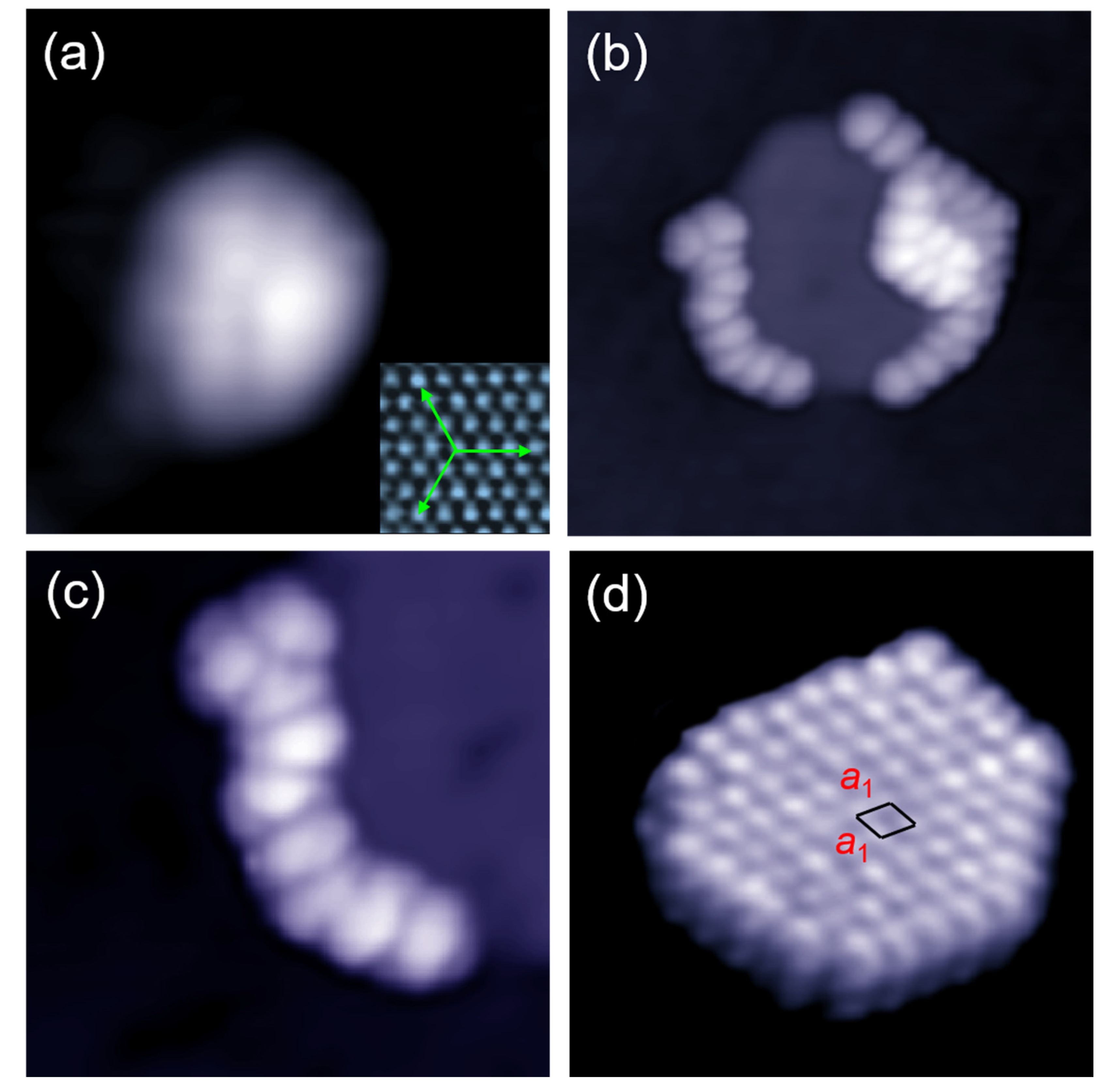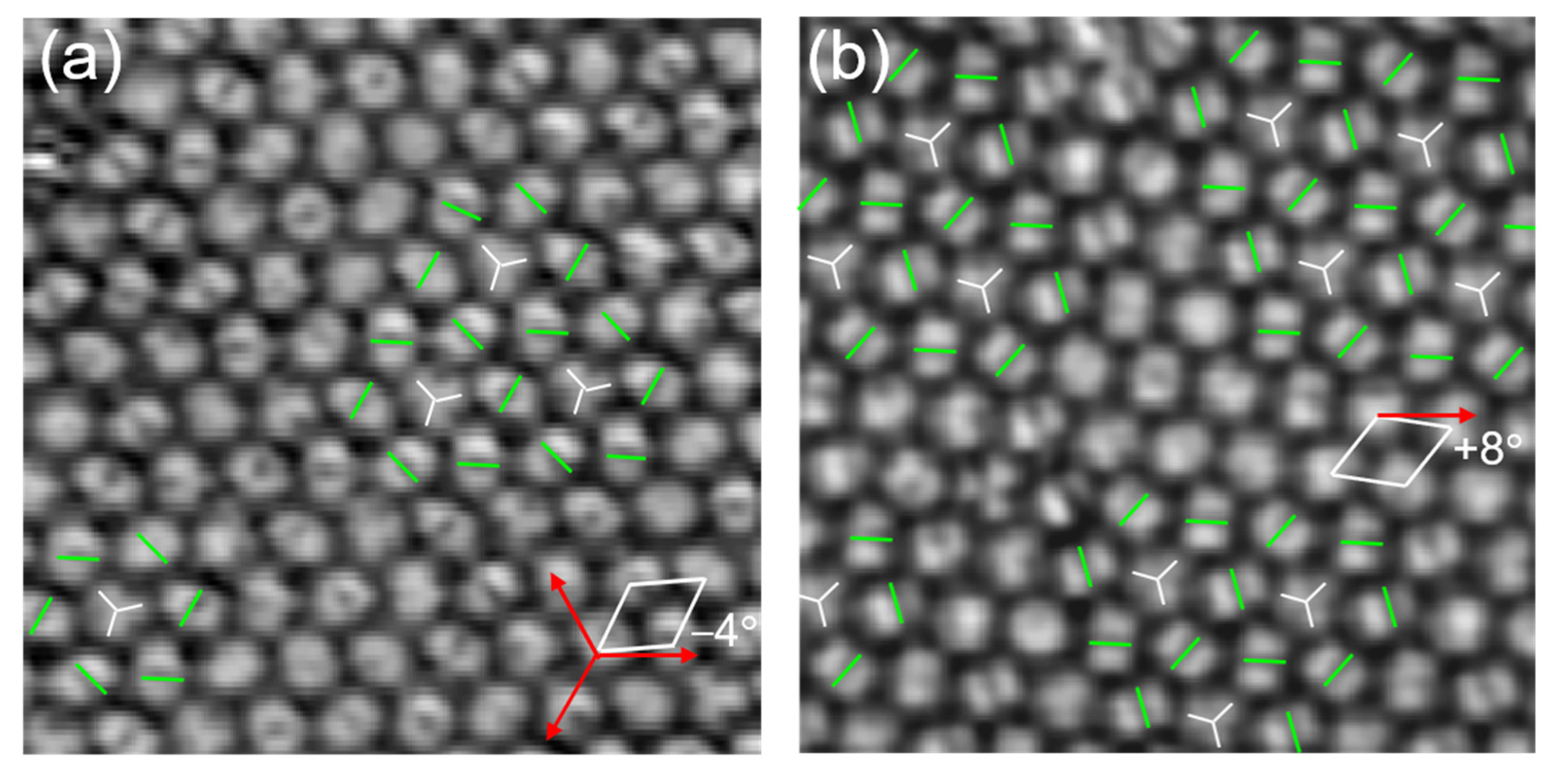Orientation Ordering and Chiral Superstructures in Fullerene Monolayer on Cd (0001)
Abstract
:1. Introduction
2. Experiment
3. Results and Discussion
4. Conclusions
Author Contributions
Funding
Acknowledgments
Conflicts of Interest
References
- Stephens, P.W.; Bortel, G.; Faigel, G.; Tegze, M.; Jánossy, A.; Pekker, S.; Oszlanyi, G.; Forró, L. Polymeric fullerene chains in RbC60 and KC60. Nature 1994, 370, 636–639. [Google Scholar] [CrossRef]
- Sakurai, T.; Wang, X.D.; Hashizume, T. Scanning tunneling microscopy studies of fullerenes. Prog. Surf. Sci. 1996, 232, 119–154. [Google Scholar]
- Yamachika, R.; Grobis, M.; Wachowiak, A.; Crommie, M.F. Controlled atomic doping of a single molecule. Science 2004, 304, 281–284. [Google Scholar] [CrossRef]
- Altman, E.I.; Colton, R.J. Determination of the orientation of C60 adsorbed on Au(111) and Ag(111). Phys. Rev. B 1993, 48, 18244–18249. [Google Scholar] [CrossRef]
- Lu, X.H.; Grobis, M.; Khoo, K.H.; Louie, S.G.; Crommie, M.F. Spatially mapping the spectral density of a single C60 molecule. Phys. Rev. Lett. 2003, 90, 096802. [Google Scholar] [CrossRef]
- Pai, W.W.; Hsu, C.L. Ordering of an incommensurate molecular layer with adsorbate-induced reconstruction: C60/Ag(100). Phys. Rev. B 2003, 68, 121403. [Google Scholar] [CrossRef]
- Pai, W.W.; Hsu, C.L.; Lin, K.C.; Sin, L.Y.; Tang, T.B. Characterization and control of molecular ordering on adsorbate-induced reconstructed surfaces. Appl. Surf. Sci. 2005, 241, 194–198. [Google Scholar] [CrossRef]
- Li, H.I.; Pussi, K.; Hanna, K.J.; Wang, L.L.; Johnson, D.D.; Cheng, H.P.; Shin, H.; Curtarolo, S.; Moritz, W.; Smerdon, J.A.; et al. Surface Geometry of C60 on Ag(111). Phys. Rev. Lett. 2009, 103, 056101. [Google Scholar] [CrossRef] [Green Version]
- Pussi, K.; Li, H.I.; Shin, H.; Loli, L.N.S.; Shukla, A.K.; Ledieu, J.; Fournee, V.; Wang, L.L.; Su, S.Y.; Marino, K.E.; et al. Elucidating the dynamical equilibrium of C60 molecules on Ag(111). Phys. Rev. B 2012, 86, 205426. [Google Scholar] [CrossRef] [Green Version]
- Li, H.I.; Abreu, G.J.P.; Shukla, A.K.; Fournée, V.; Ledieu, J.; Serkovic Loli, L.N.; Rauterkus, S.E.; Snyder, M.V.; Su, S.Y.; Marino, K.E.; et al. Ordering and dynamical properties of superbright C60 molecules on Ag(111). Phys. Rev. B 2014, 89, 085428. [Google Scholar] [CrossRef]
- Grosse, C.; Gunnarsson, O.; Merino, P.; Kuhnke, K.; Kern, K. Nanoscale Imaging of Charge Carrier and Exciton Trapping at Structural Defects in Organic Semiconductors. Nano Lett. 2016, 16, 2084–2089. [Google Scholar] [CrossRef] [PubMed]
- Schull, G.; Berndt, R. Orientationally ordered (7×7) superstructure of C60 on Au(111). Phys. Rev. Lett. 2007, 99, 226105. [Google Scholar] [CrossRef] [PubMed]
- Schull, G.; Neel, N.; Becker, M.; Kroeger, J.; Berndt, R. Spatially resolved conductance of oriented C60. New J. Phys. 2008, 10, 065012. [Google Scholar] [CrossRef]
- Zhang, X.; Yin, F.; Palmer, R.E.; Guo, Q. The C60/Au(111) interface at room temperature: A scanning tunnelling microscopy study. Surf. Sci. 2008, 602, 885–892. [Google Scholar] [CrossRef]
- Gardener, J.A.; Briggs, G.A.D.; Castell, M.R. Scanning tunneling microscopy studies of C60 monolayers on Au(111). Phys. Rev. B 2009, 80, 235434. [Google Scholar] [CrossRef]
- Tang, L.; Zhang, X.; Guo, Q.; Wu, Y.; Wang, L.; Cheng, H. Two bonding configurations for individually adsorbed C60 molecules on Au(111). Phys. Rev. B 2010, 82, 125414. [Google Scholar] [CrossRef]
- Tang, L.; Zhang, X.; Guo, Q. Organizing C60 molecules on a nanostructured Au(111) surface. Surf. Sci. 2010, 604, 1310–1314. [Google Scholar] [CrossRef]
- Tang, L.; Xie, Y.; Guo, Q. Complex orientational ordering of C60 molecules on Au(111). J. Chem. Phys. 2011, 135, 11470211. [Google Scholar] [CrossRef]
- Tang, L.; Guo, Q. Orientational ordering of the second layer of C60 molecules on Au(111). Phys. Chem. Chem. Phys. 2012, 14, 3323–3328. [Google Scholar] [CrossRef]
- Torrelles, X.; Pedio, M.; Cepek, C.; Felici, R. (2√3 × 2√3)R30 degrees induced self-assembly ordering by C60 on a Au(111) surface: X-ray diffraction structure analysis. Phys. Rev. B 2012, 86, 075461. [Google Scholar] [CrossRef]
- Shin, H.; Schwarze, A.; Diehl, R.D.; Pussi, K.; Colombier, A.; Gaudry, E.; Ledieu, J.; McGuirk, G.M.; Loli, L.N.S.; Fournee, V.; et al. Structure and dynamics of C60 molecules on Au(111). Phys. Rev. B 2014, 89, 245428. [Google Scholar] [CrossRef] [Green Version]
- Passens, M.; Waser, R.; Karthaeuser, S. Enhanced fullerene-Au(111) coupling in (2√3 × 2√3) R30 degrees superstructures with intermolecular interactions. Beilstein J. Nanotech. 2015, 6, 1421–1431. [Google Scholar] [CrossRef] [Green Version]
- Passens, M.; Karthaeuser, S. Interfacial and intermolecular interactions determining the rotational orientation of C60 adsorbed on Au(111). Surf. Sci. 2015, 642, 11–15. [Google Scholar] [CrossRef]
- Hashizume, T.; Motai, K.; Wang, X.D.; Shinohara, H.; Saito, Y.; Maruyama, Y.; Ohno, K.; Kawazoe, Y.; Nishina, Y.; Pickering, H.W.; et al. Intramolecular structures of c60 molecules adsorbed on the Cu(111)-(1 × 1) surface. Phys. Rev. Lett. 1993, 71, 2959–2962. [Google Scholar] [CrossRef]
- Abel, M.; Dmitriev, A.; Fasel, R.; Lin, N.; Barth, J.V.; Kern, K. Scanning tunneling microscopy and x-ray photoelectron diffraction investigation of C60 films on Cu(100). Phys. Rev. B 2003, 67, 245407. [Google Scholar] [CrossRef] [Green Version]
- Schulze, G.; Franke, K.J.; Gagliardi, A.; Romano, G.; Lin, C.S.; Rosa, A.L.; Niehaus, T.A.; Frauenheim, T.; Di Carlo, A.; Pecchia, A.; et al. Resonant electron heating and molecular phonon cooling in single C60 junctions. Phys. Rev. Lett. 2008, 100, 136801. [Google Scholar] [CrossRef]
- Wong, S.; Pai, W.W.; Chen, C.; Lin, M. Coverage-dependent adsorption superstructure transition of C60/Cu(001). Phys. Rev. B 2010, 82, 125442. [Google Scholar] [CrossRef] [Green Version]
- Xu, G.; Shi, X.; Zhang, R.Q.; Pai, W.W.; Jeng, H.T.; Van Hove, M.A. Detailed low-energy electron diffraction analysis of the (4 × 4) surface structure of C60 on Cu(111): Seven-atom-vacancy reconstruction. Phys. Rev. B 2012, 86, 075419. [Google Scholar] [CrossRef] [Green Version]
- Li, G.; Zhou, H.T.; Pan, L.D.; Zhang, Y.; Mao, J.H.; Zou, Q.; Guo, H.M.; Wang, Y.L.; Du, S.X.; Gao, H.J. Self-assembly of C60 monolayer on epitaxially grown, nanostructured graphene on Ru(0001) surface. Appl. Phys. Lett. 2012, 100, 0133041. [Google Scholar] [CrossRef]
- Cho, J.; Smerdon, J.; Gao, L.; Suezer, O.; Guest, J.R.; Guisinger, N.P. Structural and Electronic Decoupling of C60 from Epitaxial Graphene on SiC. Nano Lett. 2012, 12, 3018–3024. [Google Scholar] [CrossRef]
- Svec, M.; Merino, P.; Dappe, Y.J.; Gonzalez, C.; Abad, E.; Jelinek, P.; Martin-Gago, J.A. van der Waals interactions mediating the cohesion of fullerenes on graphene. Phys. Rev. B 2012, 86, 121407. [Google Scholar] [CrossRef] [Green Version]
- Jung, M.; Shin, D.; Sohn, S.; Kwon, S.; Park, N.; Shin, H. Atomically resolved orientational ordering of C60 molecules on epitaxial graphene on Cu(111). Nanoscale 2014, 6, 11835–11840. [Google Scholar] [CrossRef] [PubMed] [Green Version]
- Monazami, E.; Bignardi, L.; Rudolf, P.; Reinke, P. Strain Lattice Imprinting in Graphene by C60 Intercalation at the Graphene/Cu Interface. Nano Lett. 2015, 15, 7421–7430. [Google Scholar] [CrossRef]
- Hou, J.G.; Yang, J.L.; Wang, H.Q.; Li, Q.X.; Zeng, C.G.; Lin, H.; Bing, W.; Chen, D.M.; Zhu, Q.S. Identifying molecular orientation of individual C60 on a Si(111)-(7 × 7) surface. Phys. Rev. Lett. 1999, 83, 3001–3004. [Google Scholar] [CrossRef]
- Wang, H.Q.; Zeng, C.G.; Wang, B.; Hou, J.G.; Li, Q.X.; Yang, J.L. Orientational configurations of the C60 molecules in the (2 × 2) superlattice on a solid C60 (111) surface at low temperature. Phys. Rev. B 2001, 63, 085417. [Google Scholar] [CrossRef]
- Liu, L.; Liu, S.; Chen, X.; Li, C.; Ling, J.; Liu, X.; Cai, Y.; Wang, L. Switching Molecular Orientation of Individual Fullerene at Room Temperature. Sci. Rep. 2013, 3, 3062. [Google Scholar] [CrossRef] [PubMed] [Green Version]
- Klyachko, D.V.; Lopez-Castillo, J.M.; Jay-Gerin, J.P.; Chen, D.M. Stress relaxation via the displacement domain formation in films of C60 on Ge(100). Phys. Rev. B 1999, 60, 9026–9036. [Google Scholar] [CrossRef] [Green Version]
- Goldoni, A.; Cepek, C.; De Seta, M.; Avila, J.; Asensio, M.C.; Sancrotti, M. Interaction of C60 with Ge(111) in the 3√3 × 3√R30° phase: A (2 × 2) model. Phys. Rev. B 2000, 61, 10411–10416. [Google Scholar] [CrossRef]
- Fanetti, M.; Gavioli, L.; Cepek, C.; Sancrotti, M. Orientation of C60 molecules in the, (3√3 × 3√3)R30° and, (√13 × √13)R14° phases of C60/Ge(111) single layers. Phys. Rev. B 2008, 77, 085420. [Google Scholar] [CrossRef]
- Leaf, J.; Stannard, A.; Jarvis, S.P.; Moriarty, P.; Dunn, J.L. A combined monte carlo and huckel theory simulation of orientational ordering in C60 assemblies. J. Phys. Chem. C 2016, 120, 8139–8147. [Google Scholar] [CrossRef]
- Wang, Y.; Yamachika, R.; Wachowiak, A.; Grobis, M.; Khoo, K.H.; Lee, D.H.; Louie, S.G.; Crommie, M.F. Novel orientational ordering and reentrant metallicity in kx C60 monolayers for 3 ≤ x ≤ 5. Phys. Rev. Lett. 2007, 99, 086402. [Google Scholar] [CrossRef] [PubMed] [Green Version]
- Stark, R.W.; Falicov, L.M. Band structure and fermi surface of zinc and cadmium. Phys. Rev. Lett. 1967, 19, 795. [Google Scholar] [CrossRef]
- Daniuk, S.; Jarlborg, T.; Kontrymsznajd, G.; Majsnerowski, J.; Stachowiak, H. Electronic-structure of Mg, Zn and Cd. J. Phys. Condens. Mat. 1989, 1, 8397–8406. [Google Scholar] [CrossRef]
- Edwards, D.A.; Wallace, W.E.; Craig, R.S. Magnesium Cadmium Alloys 4. The cadmium-rich alloys—Some lattice parameters and phase relationships between 25° and 300° structure of the MgCd3 superlattice—Schottky defects and the anomalous entropy. J. Am. Chem. Soc. 1952, 74, 5256–5261. [Google Scholar] [CrossRef]
- Tao, M.; Xiao, H.; Sun, K.; Tu, Y.; Yuan, H.; Xiong, Z.; Wang, J.; Xue, Q. Visualizing buried silicon atoms at the Cd-Si(111)-7 x 7 interface with localized electrons. Phys. Rev. B 2017, 96, 125410. [Google Scholar] [CrossRef]
- Altman, E.I.; Colton, R.J. Nucleation, growth, and structure of fullerene films on Au(111). Surf. Sci. 1992, 279, 49–67. [Google Scholar] [CrossRef]
- Stasevich, T.J.; Tao, C.; Cullen, W.G.; Williams, E.D.; Einstein, T.L. Impurity Decoration for Crystal Shape Control: C60 on Ag(111). Phys. Rev. Lett. 2009, 102, 085501. [Google Scholar] [CrossRef]
- Heiney, P.A.; Fischer, J.E.; Mcghie, A.R.; Romanow, W.J.; Denenstein, A.M.; Mccauley, J.P.; Smith, A.B.; Cox, D.E. Orientational ordering transition in solid C60. Phys. Rev. Lett. 1991, 66, 2911–2914. [Google Scholar] [CrossRef]
- Kroeger, J.; Neel, N.; Limot, L. Contact to single atoms and molecules with the tip of a scanning tunnelling microscope. J. Phys. Condens. Mat. 2008, 20, 223001. [Google Scholar] [CrossRef]
- Lu, X.; Grobis, M.; Khoo, K.H.; Louie, S.G.; Crommie, M.F. Charge transfer and screening in individual C60 molecules on metal substrates: A scanning tunneling spectroscopy and theoretical study. Phys. Rev. B 2004, 70, 115418. [Google Scholar] [CrossRef]
- David, W.; Ibberson, R.; Matthewman, J. Crystal structure and bonding of ordered C60. Nature 1991, 353, 147–149. [Google Scholar] [CrossRef]






© 2020 by the authors. Licensee MDPI, Basel, Switzerland. This article is an open access article distributed under the terms and conditions of the Creative Commons Attribution (CC BY) license (http://creativecommons.org/licenses/by/4.0/).
Share and Cite
Shang, Y.; Wang, Z.; Yang, D.; Wang, Y.; Ma, C.; Tao, M.; Sun, K.; Yang, J.; Wang, J. Orientation Ordering and Chiral Superstructures in Fullerene Monolayer on Cd (0001). Nanomaterials 2020, 10, 1305. https://doi.org/10.3390/nano10071305
Shang Y, Wang Z, Yang D, Wang Y, Ma C, Tao M, Sun K, Yang J, Wang J. Orientation Ordering and Chiral Superstructures in Fullerene Monolayer on Cd (0001). Nanomaterials. 2020; 10(7):1305. https://doi.org/10.3390/nano10071305
Chicago/Turabian StyleShang, Yuzhi, Zilong Wang, Daxiao Yang, Yaru Wang, Chaoke Ma, Minlong Tao, Kai Sun, Jiyong Yang, and Junzhong Wang. 2020. "Orientation Ordering and Chiral Superstructures in Fullerene Monolayer on Cd (0001)" Nanomaterials 10, no. 7: 1305. https://doi.org/10.3390/nano10071305




